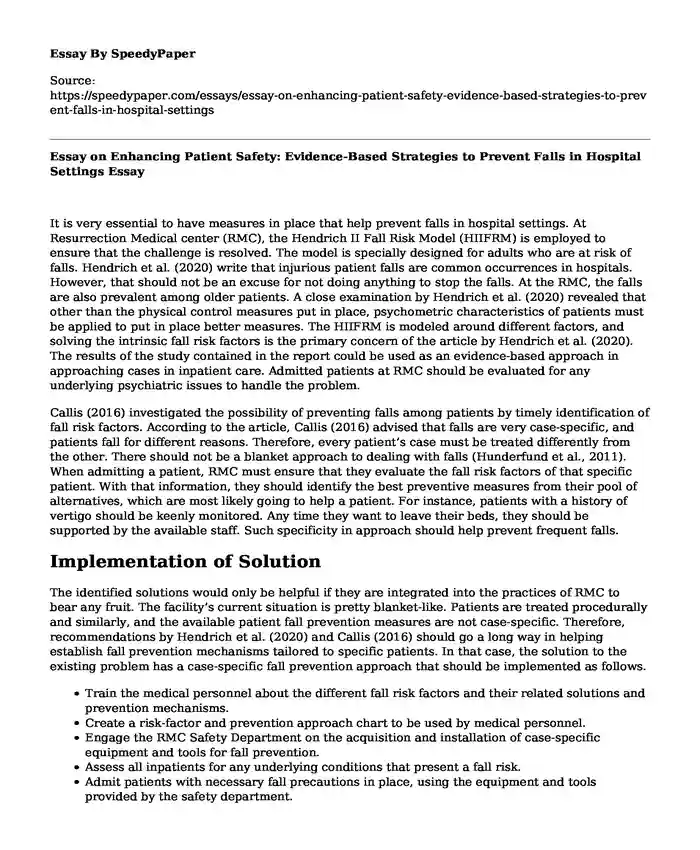
| Type of paper: | Essay |
| Categories: | Risk Health and Social Care |
| Pages: | 3 |
| Wordcount: | 666 words |
It is very essential to have measures in place that help prevent falls in hospital settings. At Resurrection Medical center (RMC), the Hendrich II Fall Risk Model (HIIFRM) is employed to ensure that the challenge is resolved. The model is specially designed for adults who are at risk of falls. Hendrich et al. (2020) write that injurious patient falls are common occurrences in hospitals. However, that should not be an excuse for not doing anything to stop the falls. At the RMC, the falls are also prevalent among older patients. A close examination by Hendrich et al. (2020) revealed that other than the physical control measures put in place, psychometric characteristics of patients must be applied to put in place better measures. The HIIFRM is modeled around different factors, and solving the intrinsic fall risk factors is the primary concern of the article by Hendrich et al. (2020). The results of the study contained in the report could be used as an evidence-based approach in approaching cases in inpatient care. Admitted patients at RMC should be evaluated for any underlying psychiatric issues to handle the problem.
Callis (2016) investigated the possibility of preventing falls among patients by timely identification of fall risk factors. According to the article, Callis (2016) advised that falls are very case-specific, and patients fall for different reasons. Therefore, every patient’s case must be treated differently from the other. There should not be a blanket approach to dealing with falls (Hunderfund et al., 2011). When admitting a patient, RMC must ensure that they evaluate the fall risk factors of that specific patient. With that information, they should identify the best preventive measures from their pool of alternatives, which are most likely going to help a patient. For instance, patients with a history of vertigo should be keenly monitored. Any time they want to leave their beds, they should be supported by the available staff. Such specificity in approach should help prevent frequent falls.
Implementation of Solution
The identified solutions would only be helpful if they are integrated into the practices of RMC to bear any fruit. The facility’s current situation is pretty blanket-like. Patients are treated procedurally and similarly, and the available patient fall prevention measures are not case-specific. Therefore, recommendations by Hendrich et al. (2020) and Callis (2016) should go a long way in helping establish fall prevention mechanisms tailored to specific patients. In that case, the solution to the existing problem has a case-specific fall prevention approach that should be implemented as follows.
- Train the medical personnel about the different fall risk factors and their related solutions and prevention mechanisms.
- Create a risk-factor and prevention approach chart to be used by medical personnel.
- Engage the RMC Safety Department on the acquisition and installation of case-specific equipment and tools for fall prevention.
- Assess all inpatients for any underlying conditions that present a fall risk.
- Admit patients with necessary fall precautions in place, using the equipment and tools provided by the safety department.
The issue of falls shall be positively impacted by the new approach. The treatment of every patient and precautions for each of them shall be based on the available patient information and not the general approach to safety. Going forward, RMC shall evaluate the success or failure of the strategy. After a year of implementation, the year’s statistics of falls should be compared against the previous year’s statistics. If there is a significant fall of about 35%, the program should be deemed a success.
References
Callis, N. (2016). Fall prevention: Identification of predictive fall risk factors. Applied Nursing Research, 29, 53-58. https://doi.org/10.1016/j.apnr.2015.05.007
Hendrich, A., Bufalino, A., & Groves, C. (2020). Validation of the Hendrich II Fall Risk Model: The imperative to reduce modifiable risk factors. Applied Nursing Research, 53, 151243. https://doi.org/10.1016/j.apnr.2020.151243
Hunderfund, A., Sweeney, C., Mandrekar, J., Johnson, L., & Britton, J. (2011). Effect of a multidisciplinary fall risk assessment on falls among neurology inpatients. Mayo Clinic Proceedings, 86(1), 19-24. https://doi.org/10.4065/mcp.2010.0441
Cite this page
Essay on Enhancing Patient Safety: Evidence-Based Strategies to Prevent Falls in Hospital Settings. (2023, Nov 10). Retrieved from https://speedypaper.net/essays/essay-on-enhancing-patient-safety-evidence-based-strategies-to-prevent-falls-in-hospital-settings
Request Removal
If you are the original author of this essay and no longer wish to have it published on the SpeedyPaper website, please click below to request its removal:
- Health Essay Example
- To Kill a Mockingbird
- Psychology Essay Example: Depression Case Study
- Essay Example: Impact of Special Trade Zones in India on a Socio-Economic Level
- Essay sample on Aviation History
- Essay Example. The Tuskegee Experiment Case Study
- Ventilator-Associated Pneumonia (VAP): Nursing in the ICU - Essay Sample
Popular categories




